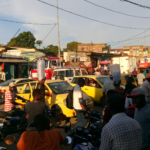Bulletin’s Exec Director Kennette Benedict to Speak at June 6 Rocky Flats Anniv
By Dan Drollette | May 28, 2014
Bulletin Media Contact: Janice Sinclaire, [email protected]
CHICAGO– May 28, 2014– Kennette Benedict, executive director of the Bulletin of the Atomic Scientists, will chair a citizen forum at Rocky Flats Then and Now: 25 Years After the Raid, an event commemorating the 25th anniversary of the United States government’s raid on the Rocky Flats Nuclear Munitions Plant. This extraordinary raid on a US Department of Energy nuclear weapons facility was conducted by the Federal Bureau of Investigations (FBI) and the Environmental Protection Agency (EPA), and began the first investigation of criminal violations of environmental laws at a major nuclear weapons facility in the US.
The citizen forum, entitled “Personal Memories of the June 6, 1989 Raid,” kicks off a 3-day event hosted by the Arvada Center for the Arts and Humanities. “A citizen forum gives us the chance to reflect on significant events in the nuclear era,” said Benedict. “What happened and why? And how were the people living and working around the facility affected by the serious environmental hazards exposed at Rocky Flats and by the subsequent closing of the plant?”
Speakers at the event will include former Colorado Governor Roy Romer; former U.S. Representative David Skaggs; former FBI agent Jon Lipsky; and former Bulletin editor Len Ackland (author of Making a Real Killing: Rocky Flats and the Nuclear West), as well as former plant workers, neighbors, activists and experts. The event is free and open to the public. For more information go to: Rocky Flats Then and Now: 25 Years After the Raid
Dr. Benedict is available to speak to the media regarding the raid at Rocky Flats; a compilation of Bulletin articles regarding both Rocky Flats and the history of the nuclear weapons complex in the United States is also available.
About the Bulletin of the Atomic Scientists:
Founded in 1945 by University of Chicago scientists who helped develop the first atomic weapons in the Manhattan Project, the Bulletin of the Atomic Scientists created the Doomsday Clock two years later, using the imagery of apocalypse (midnight) and the contemporary idiom of nuclear explosion (countdown to zero), to convey threats to humanity and the planet. The Clock subsequently became a universally recognized indicator of the world's vulnerability to catastrophe from nuclear weapons, climate change, and other technological threats to humanity. A decision on whether to move the Clock's minute hand closer to or further from midnight is made once each year by the Bulletin's Science and Security Board, in consultation with the organization's Board of Sponsors, which includes 18 Nobel laureates. The Bulletin has a long tradition of publishing original and provocative articles by the smartest minds in the fields it covers, including, among others, Hans Bethe, Albert Einstein, Leo Szilard, Edward Teller, J. Robert Oppenheimer, Michael Polanyi, and Mikhail Gorbachev. It won a National Magazine Award for General Excellence in 2007.
Bulletin Media Contact: Janice Sinclaire, [email protected]
Together, we make the world safer.
The Bulletin elevates expert voices above the noise. But as an independent nonprofit organization, our operations depend on the support of readers like you. Help us continue to deliver quality journalism that holds leaders accountable. Your support of our work at any level is important. In return, we promise our coverage will be understandable, influential, vigilant, solution-oriented, and fair-minded. Together we can make a difference.














